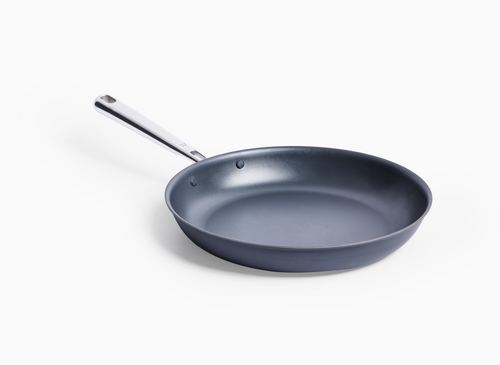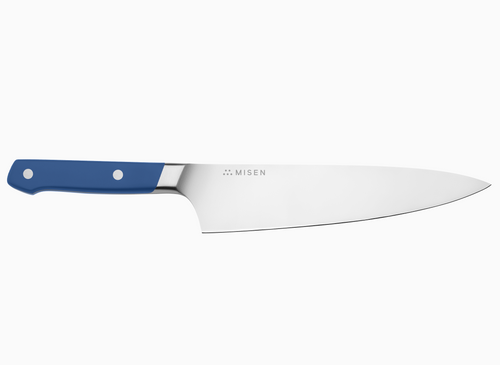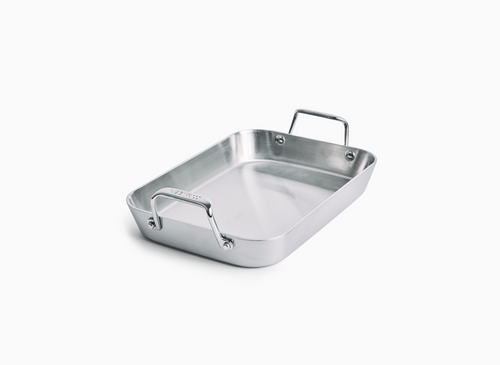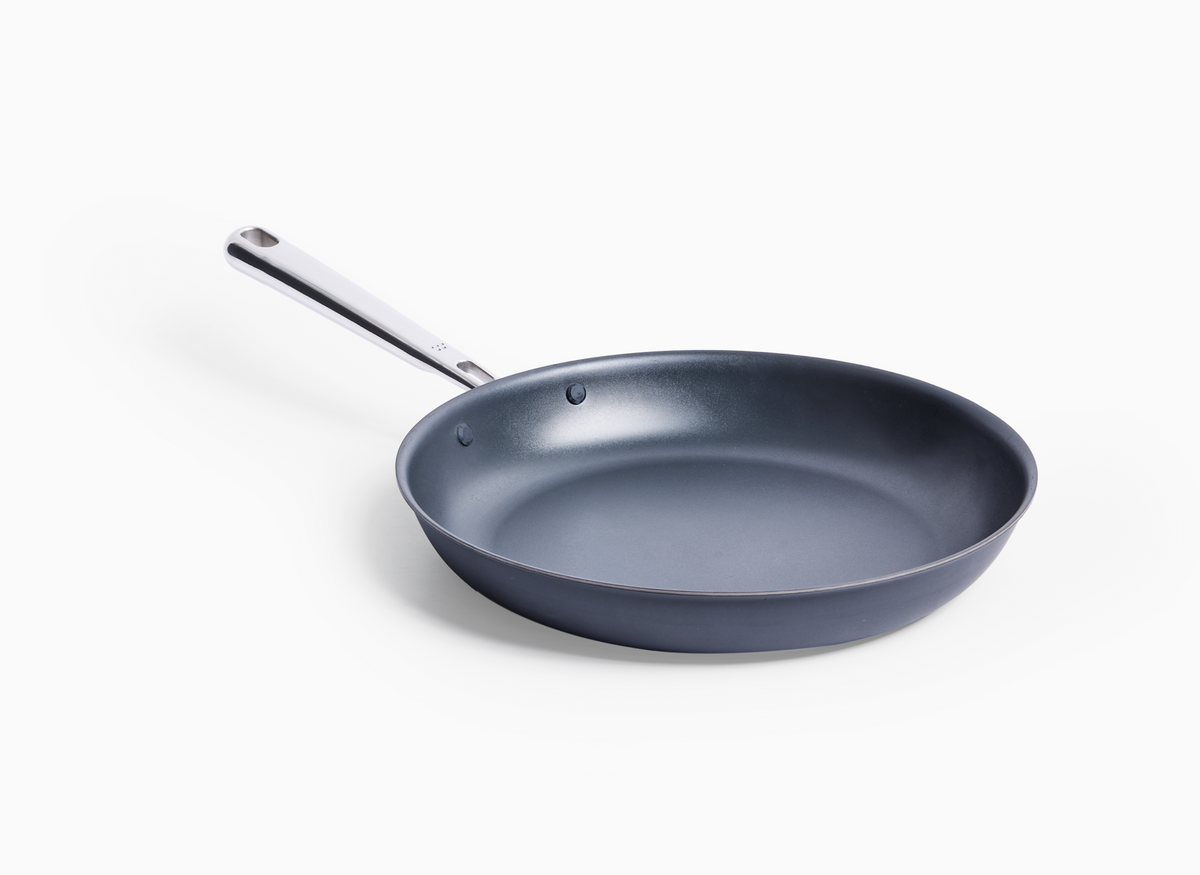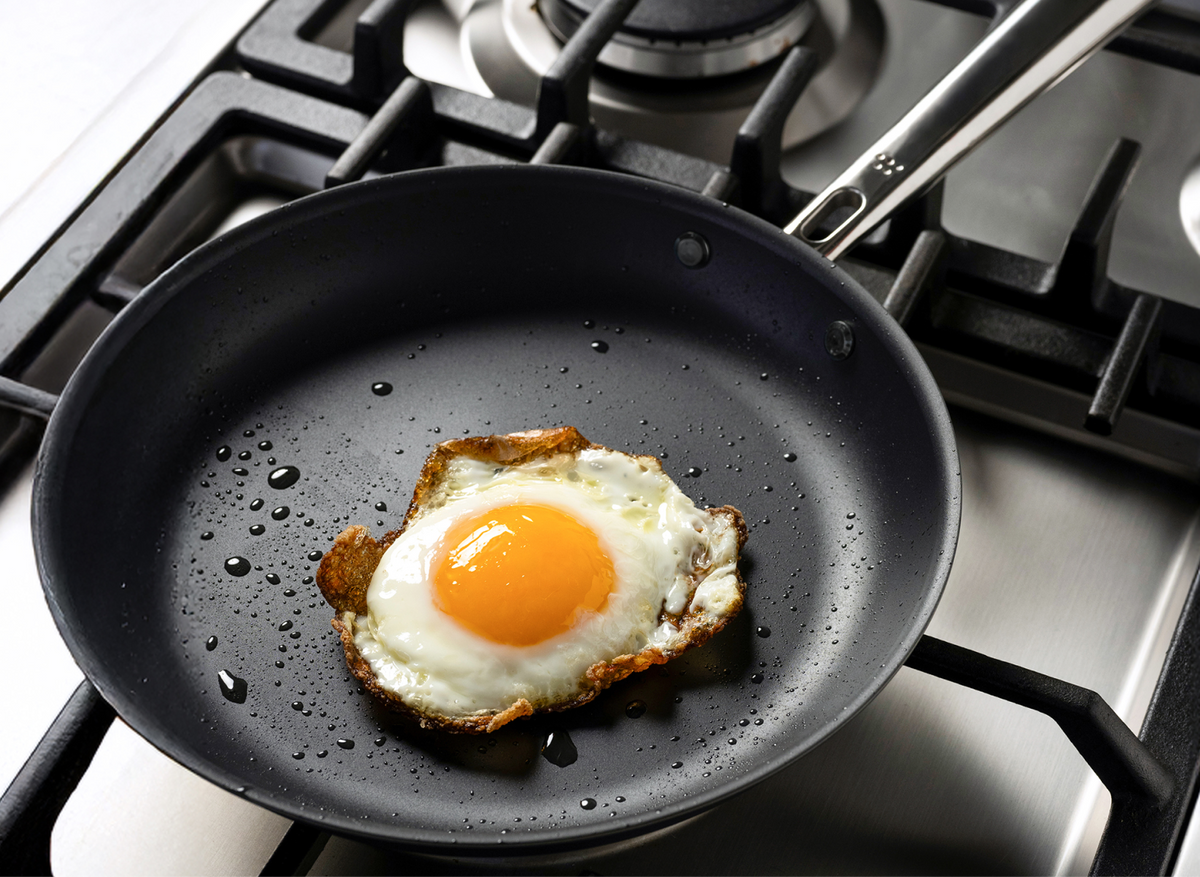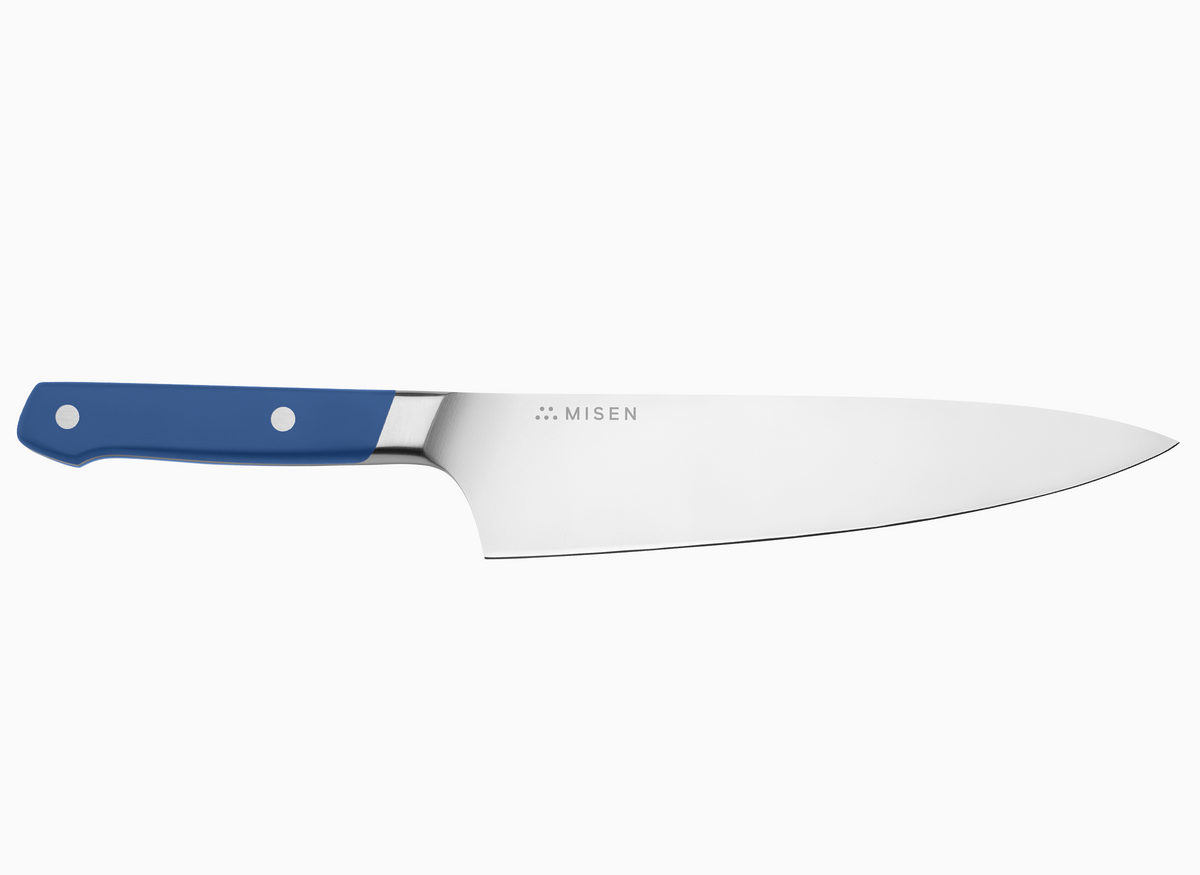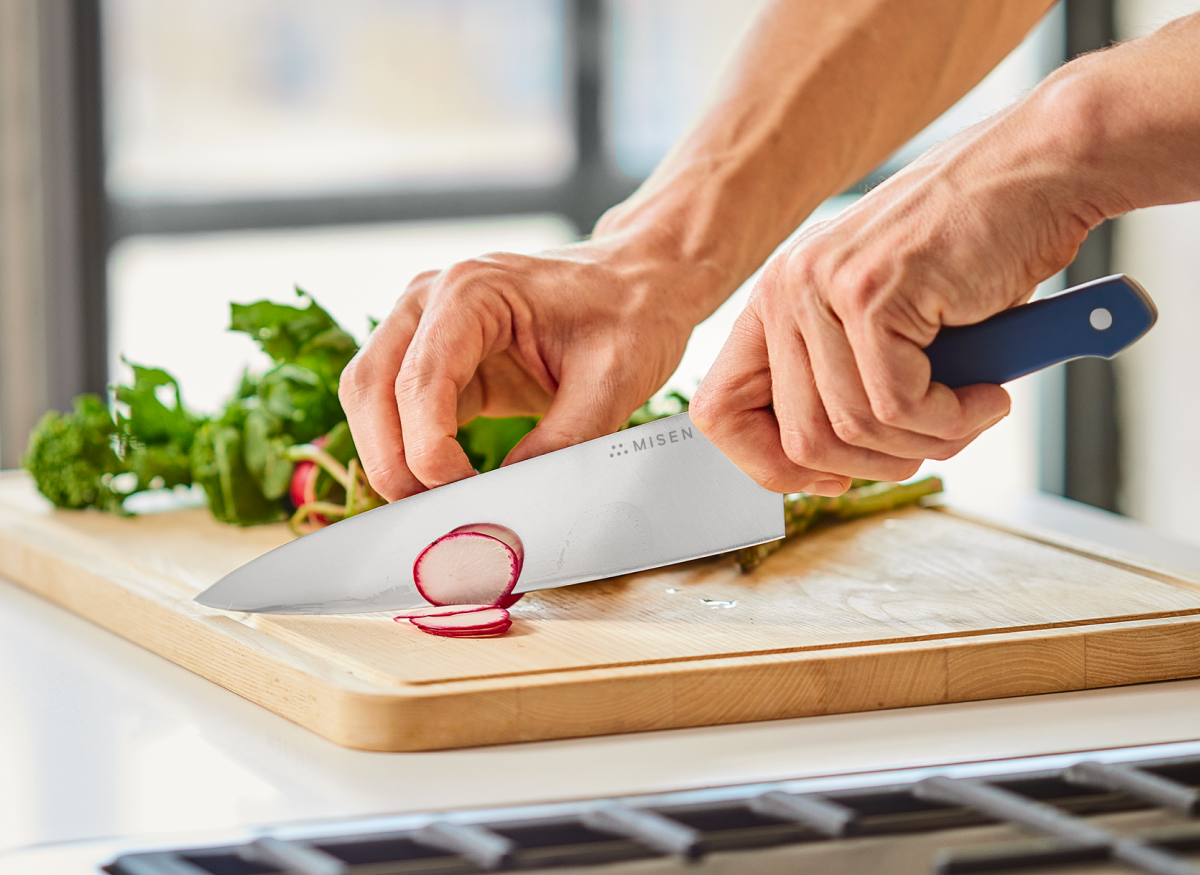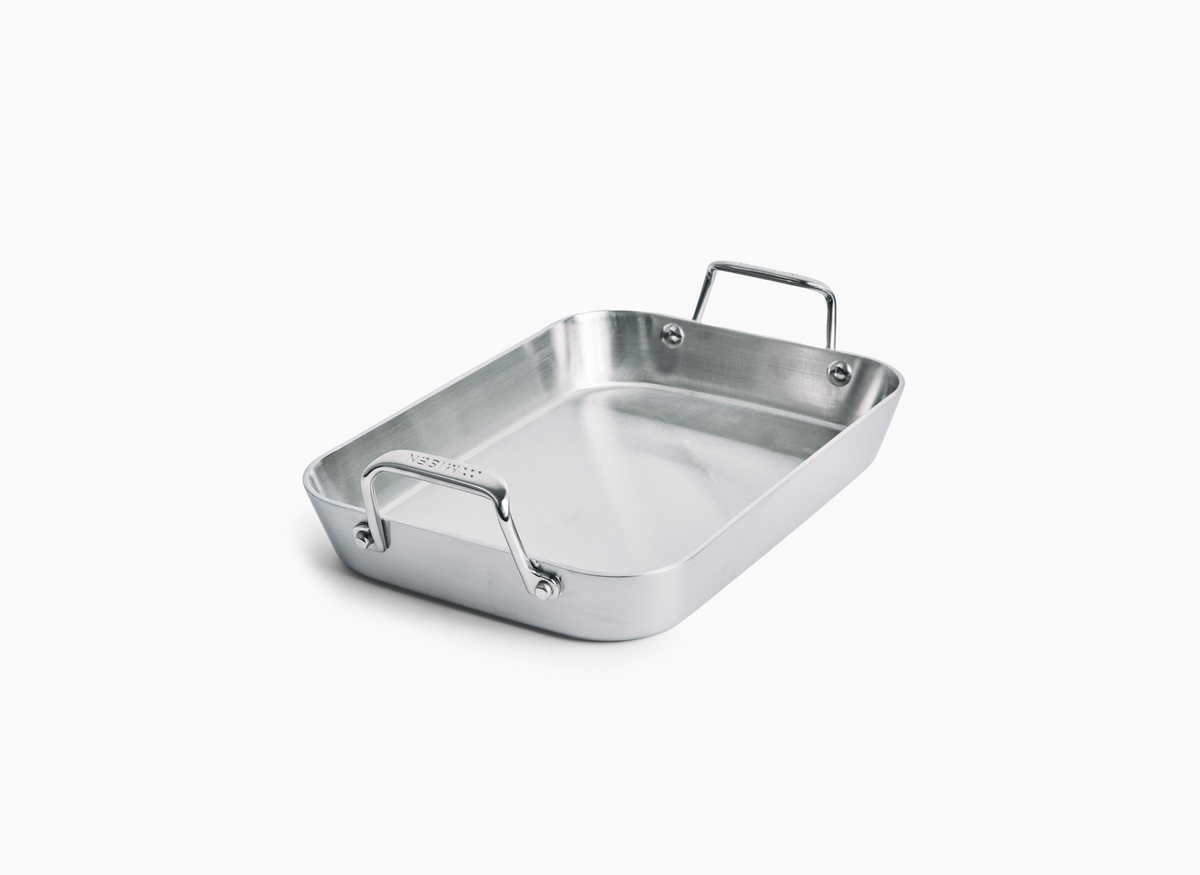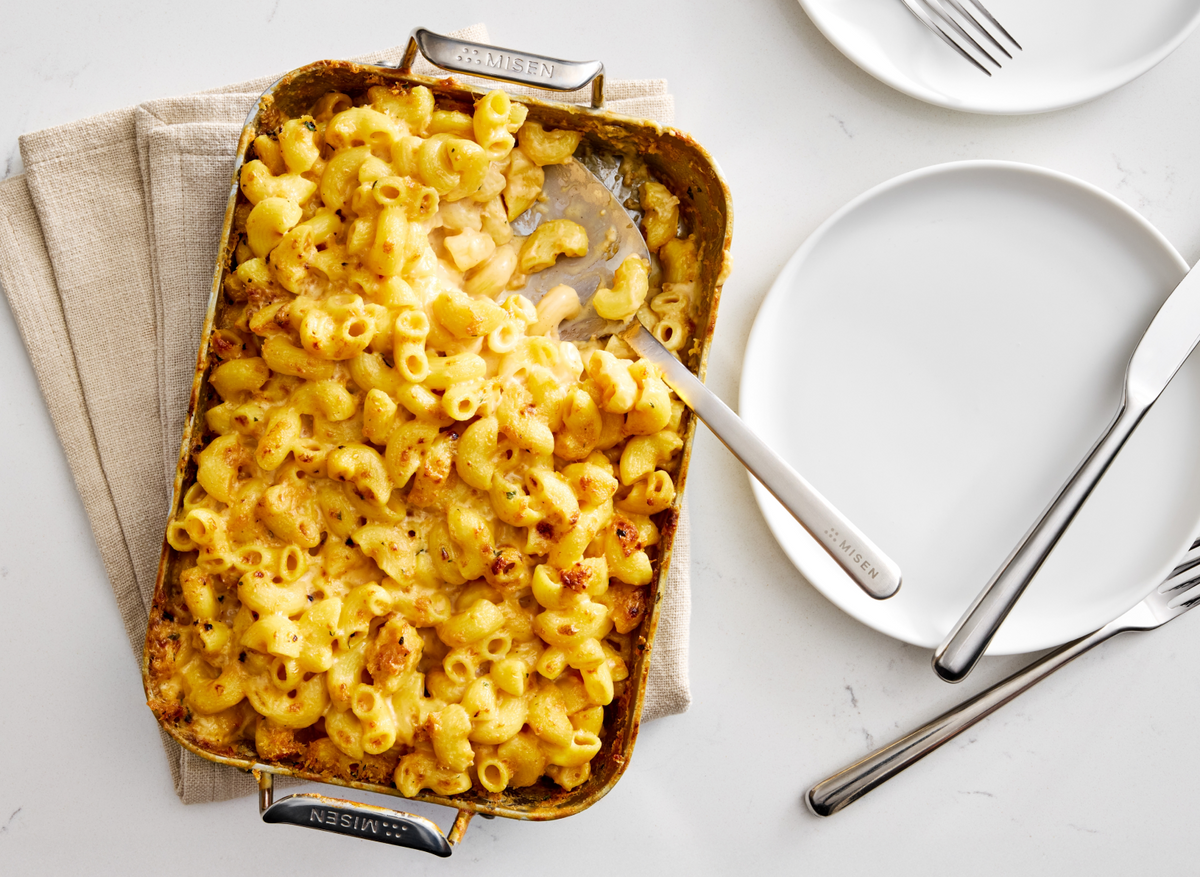Chiffonade Kale: Tender Strips for Hearty Salads and Sautés

Step-by-Step Guide to Chiffonade Kale
Proper preparation is key: thoroughly dry your kale and use a sharp knife with a smooth rocking motion to achieve perfect, even ribbons.
Preparing Your Kale: Washing, Drying, and De-stemming
Choose the freshest, crispiest kale you can find and prep it within a day or two for best results. Start by rinsing off any obvious dirt, then strip the leaves from the stems - just hold the bottom of each stem and run your other hand up to pull off the leafy parts. Here's a pro tip: fill your salad spinner with ice water and let the de-stemmed leaves soak for 5 minutes. This not only cleans them thoroughly but actually makes them crisper. Give the leaves a good swish to knock loose any stubborn debris. Now comes the important part - dry them really well. Spin the kale multiple times, draining between rounds. Then spread the leaves on a clean kitchen towel, fold it over burrito-style, and gently roll to soak up the last drops. Let everything air dry for about 20 minutes. Taking time with this step makes all the difference in your final cuts.
Stacking and Rolling: Creating the Foundation for Perfect Cuts
Once your kale is completely dry, you're ready to stack and roll. Take 3-4 large leaves (or 4-6 smaller ones) and layer them from biggest to smallest, with the largest on bottom. Make sure they're all facing the same way - glossy sides down works best. Now roll them up tightly from one end, just like you'd roll a yoga mat. The key is keeping steady, even pressure so you get a nice, firm cylinder that won't unravel on you. This technique might feel awkward at first, but it's what gives you those perfect, even strips every time. Before you start cutting, curl your fingertips under and use your knuckles as a guide for the knife - this keeps your fingers safe while maintaining control.
Slicing Technique: Achieving Consistent Ribbon-like Strips
Now for the actual cutting - this is where a sharp chef's knife makes all the difference. Position your rolled kale on the cutting board and hold it firmly with your non-dominant hand, keeping those fingertips curled under. Use a gentle rocking motion with your knife, letting the blade do the work rather than forcing it through. Aim for strips about 1/8 to 1/4 inch wide - any thinner and they'll wilt too quickly, any thicker and they won't integrate well into dishes. The beauty of chiffonade is that it creates uniform strips that cook evenly and distribute perfectly throughout salads. Keep your knife at a consistent angle and maintain steady rhythm. If you notice the strips sticking together, gently separate them with your fingers after cutting. This technique works for any leafy green or herb, so once you master it with kale, you can apply it to basil, collards, or Swiss chard.
Video Demonstration and Common Mistakes to Avoid
Here's what to watch for when you're perfecting your technique. First, make sure those leaves are bone dry - wet kale equals soggy, limp strips that stick together. A sharp knife is non-negotiable; dull blades bruise the edges and turn them dark. When cutting, use a smooth rocking motion rather than chopping straight down. Think of it like slicing fresh herbs, not hacking through vegetables. The most common mistakes? Rolling too loosely (you'll get wonky, uneven strips), pressing too hard with the knife (let it glide through), and rushing the drying step. Once you nail this technique, you'll find endless uses - toss the ribbons into salads for better dressing coverage, float them on soups as a fresh garnish, or stir them into pasta where they'll wilt perfectly. The thin strips mean everything cooks evenly and nothing gets tough or chewy.
Beyond the Cut: Preparing Kale for Optimal Texture and Flavor
Massaging kale for just 2-3 minutes transforms its texture from tough to tender by breaking down the cellulose structure and reducing bitterness.
Different Types of Kale and How They Respond to Chiffonade
Each type of kale responds differently to the chiffonade technique based on its unique texture and structure. Curly kale, with its densely packed, crinkled leaves, requires thorough massaging before cutting to achieve tender strips, though its frilly edges create dramatic presentation in the final dish [6]. Tuscan kale (also called lacinato or dinosaur kale) produces the most consistent chiffonade results due to its thinner, flatter leaves that are naturally more tender than other varieties [6]. Its pebbled texture and uniform shape make it ideal for creating clean, even strips. Russian red kale offers a middle ground - its flat leaves with ruffled edges create visually striking ribbons with a texture between curly and Tuscan varieties [7]. The stems of all varieties should be removed before chiffonading, as they remain tough and woody regardless of cutting technique [7].
Massaging Techniques to Break Down Fibrous Texture
Raw kale's tough, fibrous texture requires breaking down before eating. Massaging kale for 2-3 minutes transforms it from tough to tender by breaking down its cellulose structure, making it easier to chew and digest while reducing bitterness [8]. Start by drizzling prepared kale with either olive oil or an acidic liquid like lemon juice or vinegar - about one tablespoon per bunch. Using your hands, gently scrunch and rub the leaves between your palms, working the liquid into every crevice until the kale noticeably softens and turns vibrant green [9]. This simple technique makes raw kale significantly more palatable and brings out its natural flavors while maintaining its nutritional benefits [8].
Oil-Based vs. Oil-Free Softening Methods
Kale can be tenderized effectively with or without oil, building on the massaging techniques described above. For oil-based softening, olive oil, avocado oil, or coconut oil work equally well - the key is working the oil into the leaves for 2-3 minutes until they turn vibrant green [10]. For oil-free preparation, lemon juice or vinegar breaks down the tough fibers just as effectively. You can either massage these acids directly into the leaves or let the kale marinate in an acidic dressing for 30 minutes [10]. Another oil-free method involves soaking the chopped kale in warm water, which helps clean the leaves while naturally reducing bitter compounds. The acid from citrus or vinegar continues tenderizing the leaves over time, making this method ideal for make-ahead preparations. Regardless of method chosen, avoid over-processing - stop when the kale is just softened but still maintains some texture [10].
Flavor Enhancers: Acids, Salts, and Other Treatments
Kale's natural bitterness comes from glucosinolates - compounds of glucose, amino acids, and sulfur that form when the leaves are cut or chewed. To reduce this bitterness, rinse kale both before and after cutting - the second rinse removes bitter compounds called isothiocyanates that form when cells are damaged during prep [12]. For additional flavor enhancement, combine the massaging technique with salt, working it into the leaves until they just begin to wilt. This helps distribute seasonings evenly while tenderizing. Acidic ingredients like lemon juice or vinegar serve double duty - they both improve flavor and continue breaking down tough fibers over time. For optimal results, combine multiple treatments: give the kale a warm water soak to clean and tenderize it, then dress with acid and let rest for at least 20 minutes before serving [12]. This resting period allows the dressing's oil to penetrate the waxy leaf surface, creating more tender, flavorful results [12].
Fresh Applications: Chiffonade Kale in Raw Dishes
Chiffonade-cut kale creates better texture balance in salads and can be dressed ahead of time without wilting, making it perfect for meal prep.
Building Better Kale Salads with Chiffonade Technique
Chiffonade-cut kale creates thin, uniform strips that distribute evenly throughout salads while making the leaves more tender and easier to eat. The technique transforms traditionally tough kale into delicate ribbons that readily absorb dressings and pair well with other ingredients [13]. For optimal results, dress the cut kale with a citrus-based vinaigrette and allow it to sit briefly - this helps soften the leaves while maintaining their structure [14]. The thin strips also create better texture balance when combined with fruits, nuts, and cheese - as demonstrated in combinations like nectarines with slivered almonds and shaved pecorino [13]. Unlike delicate lettuces, chiffonade kale salads can be dressed ahead of time without wilting, making them ideal for meal prep and holiday gatherings [15]. The sturdy nature of kale allows these salads to stay fresh for up to three days when properly stored, though the greens will continue to soften over time [15].
Complementary Ingredients That Balance Kale's Robust Flavor
Kale's robust flavor profile requires thoughtful ingredient pairings to create balanced, satisfying dishes. Colorful root vegetables provide natural sweetness and contrasting textures that complement kale's hearty nature [16]. Creamy elements like avocado help mellow the greens while adding richness, and crunchy roasted chickpeas introduce protein and textural contrast [16]. For brightness and subtle sweetness, dried cranberries work well against kale's slight bitterness, while pepitas (pumpkin seeds) add nutty depth and crunch [16]. A vibrant carrot-ginger dressing brings everything together - its refreshing tanginess and creamy texture help tenderize the leaves while enhancing their natural flavors [16]. When building kale-based dishes, aim to include elements from multiple texture and flavor categories: creamy (avocado), crunchy (seeds/nuts), sweet (dried fruit), and tangy (citrus-based dressings) [16].
Creative Slaws and No-Cook Side Dishes
Chiffonade kale transforms into vibrant slaws that offer a fresh twist on traditional coleslaw. For a winter-inspired version, combine chiffonade kale with shaved brussels sprouts, radicchio, and cabbage, then toss with a bright lemon dressing, sliced almonds, dried cranberries, and Parmesan cheese [17]. The thin strips distribute evenly while maintaining their structure, making kale slaw ideal for meal prep and gatherings since it stays fresh for up to 4 days when properly stored [17]. For an Asian-inspired variation, pair the kale ribbons with julienned carrots and radishes, topped with toasted peanuts and sesame seeds - the key is careful knife work to ensure even wilting under the dressing [19]. Unlike traditional coleslaw, kale slaws benefit from resting time as the dressing continues to tenderize the leaves while vegetables maintain their crunch [18]. Create quick no-cook sides by massaging the chiffonade kale with olive oil and citrus, then combining with ingredients like apples, walnuts, and cranberries for a balance of sweet and savory flavors [18].
Serving and Presentation Tips for Maximum Visual Appeal
Transform chiffonade kale into visually striking presentations by applying key plating principles. Create height and dimension by stacking the kale ribbons rather than laying them flat - this adds visual interest while guiding the diner's eye across the plate [20]. Use the rule of thirds when arranging components, placing the main protein slightly off-center with kale ribbons thoughtfully positioned around it rather than piling everything in the middle [21]. Add pops of contrasting color and texture by incorporating vibrant garnishes like microgreens, which provide delicate touches that make the dish feel complete without overwhelming the main elements [21]. Keep plate rims clean and free of stray pieces, using a damp cloth to wipe away any smudges before serving - this frames the dish like artwork and elevates even simple preparations [21]. When saucing, create intentional patterns like swooshes or dots rather than random drizzles, using squeeze bottles for precise control that enhances the overall composition [20].
Cooked Applications: Chiffonade Kale in Hot Dishes
Thin chiffonade strips cook rapidly and evenly, creating perfect texture contrast with crispy edges and tender centers in just five minutes.
Quick Sautés: How Thin Strips Cook Evenly and Quickly
Chiffonade-cut kale cooks rapidly and evenly thanks to its uniform thin strips. These ribbons, typically 1/8 to 1/4 inch wide, distribute heat consistently while maintaining their structure during cooking. For quick stovetop preparation, heat a heavy skillet until hot, then add the kale ribbons with just a sprinkle of salt - no oil needed initially. Move the leaves around the pan until they develop charred, crispy edges while keeping bright green tender spots. This dry-skillet method takes only five minutes and creates perfect texture contrast - some parts become earthy and crisp while others stay vibrant and tender. After cooking, finish with a light drizzle of olive oil and your preferred seasonings. Try adding paprika and cayenne when preparing kale for breakfast dishes alongside eggs.
Soups, Stews, and Braises Enhanced with Chiffonade Kale
Chiffonade kale enhances soups and stews with both visual appeal and practical benefits. The thin, uniform strips distribute evenly throughout the broth while maintaining their structure during cooking. Traditional Portuguese caldo verde soup showcases this technique beautifully, with finely shredded greens as its signature element. When adding chiffonade kale to soups, timing matters - add it near the end of cooking for clear broths to maintain bright green color and prevent overcooking. The technique shines in hearty dishes like Portuguese kale soup, where delicate ribbons complement potatoes and smoked sausage while creating the soup's signature look. For best results in braises and stews, layer the kale strips between other ingredients rather than stirring them in all at once. This allows gradual wilting while maintaining shape. The thin strips absorb cooking liquid flavors more effectively than roughly chopped pieces.
Pasta and Grain Dishes with Integrated Greens
Chiffonade kale integrates seamlessly into pasta dishes, adding nutrition and visual appeal. For a Mediterranean-inspired dish, combine thin kale ribbons with artichoke hearts, feta cheese, and sun-dried tomatoes, then toss with red wine vinaigrette. The kale maintains its structure without getting soggy for up to 5 days when stored properly. When preparing whole wheat pasta dishes, use kale as an elevated twist on classic Italian 'aglio olio e peperoncino.' Toss the greens with garlic- and chilli-infused oil until well-seasoned, then finish with a generous dusting of salty Pecorino Romano (Parmesan works too). For heartier grain dishes, lacinato kale provides earthy depth when braised. Gently cook the thin strips in bone broth or water with aromatics for a tender yet structured addition that absorbs surrounding flavors while maintaining integrity.
Recipe Ideas: From Breakfast Scrambles to Dinner Mains
Transform chiffonade kale into satisfying meals throughout the day. For a simple breakfast scramble, sauté kale ribbons until soft, add eggs, and scramble together. Finish with garlic powder and sea salt. Create more complex flavors by combining kale with harissa paste, bell peppers, and crumbled bacon - top with feta and pepperoncini for extra zip. Add seasonal vegetables like diced sweet potatoes or tomatoes to your kale-egg combinations for heartier texture and maintained nutrition. For dinner, cook the kale ribbons with minced garlic as you would sautéed spinach, creating an elegant side dish that complements any protein.
Storage and Advanced Techniques
Properly stored chiffonade kale stays fresh for 5-6 days in the fridge, and freezing preserves nutrients while extending shelf life to 6 months.
Storing Fresh Chiffonade Kale: Preventing Oxidation and Wilting
Once you've mastered the chiffonade cut, proper storage keeps your kale fresh and ready to use. For whole kale leaves, skip the wash and wrap them in a clean kitchen towel or paper towels before tucking into a storage bag - just swap out the towels every few days [32]. Pre-cut chiffonade kale needs extra care: make sure it's thoroughly dry, then layer it in an airtight container with paper towels to absorb any lingering moisture. Glass containers work great if you're avoiding plastic [32]. Your prepped kale will stay fresh for 5-6 days in the fridge (cooked kale keeps for about 5 days too) [32]. Trust your senses - if the leaves look wilted or yellowed, feel mushy, or smell off, it's time to toss them [32].
Make-Ahead Strategies for Meal Prep
Smart meal prep means having chiffonade kale ready when you need it. Since we already covered the washing and drying basics (see "Preparing Your Kale" above), let's focus on storage specifics for prepped kale. After creating your perfect ribbons with a sharp chef's knife, store them in an airtight container lined with paper towels - these absorb moisture that can make kale soggy [33]. Remember to swap out damp towels as needed. Your prepped chiffonade stays fresh for 3-5 days, ready to toss into smoothies, salads, or that quick weeknight stir-fry [34]. The beauty of this method? You've already done the hard work of transforming tough leaves into tender strips that hold their shape beautifully [1].
Freezing Techniques for Extended Preservation
Want to stock up on kale? Freezing works brilliantly - your chiffonade strips will keep for up to 6 months [32]. You've got two options here. For the best color and mildest flavor, blanch first: drop your kale into boiling water (use about 4 cups kale per gallon of water) for 2-3 minutes, then plunge into an ice bath [36]. But honestly? You can skip blanching and freeze raw kale directly - it works great in smoothies, soups, and stews where other flavors balance out any bitterness [35]. The best part about frozen kale is convenience: toss it straight into hot dishes without thawing. Just remember to thaw and drain it for baked goods so you don't add unwanted moisture [35]. Here's a bonus: freezing actually helps preserve nutrients rather than destroying them, so you're not sacrificing nutrition for convenience [35].
Taking Your Skills to the Next Level: Variations and Innovations
Ready to level up your chiffonade game? This technique adapts beautifully to different greens and herbs. When working with delicate basil or mint, stack just 3-4 large leaves (or 4-6 small ones) for better control - you'll avoid bruising those tender leaves [37]. Lacinato kale deserves special treatment too: build a flavor base with aromatics like mirepoix before braising to complement those earthy flavors [28]. The secret to perfect ribbons? Keep your blade angle consistent and let your knuckles guide the knife - technique beats equipment every time [38]. Here's what makes chiffonade special: those thin cuts actually release more aromatic compounds than rough chopping, which means more flavor in every bite. Whether you're garnishing a soup or building a salad, this technique brings both elegance and intensity to your dishes [38].
- Proper preparation is crucial - thoroughly wash, dry, and de-stem kale before chiffonading for best results
- Stack 3-4 large leaves (or 4-6 small ones), roll tightly like a yoga mat, and cut with a sharp knife using a gentle rocking motion
- Massaging kale for 2-3 minutes with oil or acid breaks down tough fibers and reduces bitterness
- Different kale varieties respond differently to chiffonade - Tuscan kale produces the most consistent results
- Chiffonade kale stays fresh for 5-6 days refrigerated or up to 6 months frozen
- Thin strips cook evenly in just 5 minutes and integrate beautifully into both raw and cooked dishes
- For meal prep success, store cut kale in airtight containers with paper towels to absorb moisture
We've compiled these references to help you explore the chiffonade technique and kale preparation methods in greater depth. Each source contributed valuable insights to this comprehensive guide.
- https://www.thefauxmartha.com/how-to-prep-kale-for-the-week/
- https://misen.com/blogs/news/chiffonade-cut-definition-master-the-art-of-fine-slicing?srsltid=AfmBOooST4OogwKqu6m2UwYxwrcFZ1jEiGdH8hQneSKxZy-WANmr1YCm
- https://www.wellandgood.com/food/how-to-chop-kale
- https://totaste.com/how_tos/chiffonade/
- https://www.cookingclarified.com/2017/09/how-to-chiffonade/?noamp=mobile
- https://www.bonappetit.com/story/types-of-kale?srsltid=AfmBOorVJuabcrNtw5fUMonvdAcqQi8hSI-DBFpmU7pei45ucSpnhSG_
- https://www.foodrepublic.com/1702780/curly-tuscan-russian-red-kale-types-explained/
- https://playswellwithbutter.com/how-to-massage-kale/
- https://itsavegworldafterall.com/how-to-soften-kale/
- https://foolproofliving.com/how-to-massage-kale/
- https://www.allrecipes.com/article/why-do-you-have-to-massage-kale/
- https://www.americastestkitchen.com/articles/6783-make-kale-less-bitter
- https://www.adventurekitchen.com/recipes/2017/6/15/lemon-kale-chiffonade-with-summer-fruit
- https://tastecooking.com/recipes/kale-salad-started/
- https://www.spabettie.com/lemony-brussels-and-kale-chiffonade-salad/
- https://www.loveandlemons.com/kale-salad/
- https://www.acedarspoon.com/winter-coleslaw-salad/
- https://urbanfarmie.com/best-kale-salads/
- https://localkitchenblog.com/2012/06/20/asian-kaleslaw/
- https://cosori.com/blogs/blog/how-to-plate-food?srsltid=AfmBOoposb_dIvainoO0rtRl90HT9iRQZdpcyz7DfveJR2sTsLNJ646V
- https://www.culinaryartsswitzerland.com/en/news/plating-food/
- https://www.bonappetit.com/story/dry-skillet-cooked-kale-recipe?srsltid=AfmBOoqEpkJcOl9QQ2V3aC-d_NQwRahZRu7Vc5xm5-leRrLtdDK65KeG
- https://foodwishes.blogspot.com/2017/11/caldo-verde-my-green-soup-redux.html
- https://www.thefooddictator.com/the-hirshon-portuguese-kale-and-sausage-soup-caldo-verde/
- https://www.bowlofdelicious.com/caldo-verde/
- https://www.daisybeet.com/quick-healthy-mediterranean-kale-pasta-salad/
- https://www.greatbritishchefs.com/recipes/whole-wheat-penne-recipe-with-kale-pecorino
- https://thenourishedepicurean.com/braised-lacinato-kale-chiffonade/
- https://bloominthyme.com/recipes/savory/kale-scramble/
- https://www.allrecipes.com/recipe/272924/breakfast-scramble/
- https://www.thehungryhutch.com/kale-and-eggs/
- https://foolproofliving.com/how-to-store-kale/
- https://kristineskitchenblog.com/how-to-wash-and-store-kale-for-smoothies-and-salads/
- https://plantbasedfoody.com/how-to-meal-prep-kale/
- https://thenaturalnurturer.com/how-to-freeze-kale-recipes-for-how-to-use-it/
- https://www.hobbyfarms.com/5-easy-ways-to-preserve-kale-for-long-term-storage-and-use/
- https://www.forksoverknives.com/how-tos/how-to-chiffonade/
- https://misen.com/blogs/news/chiffonade-herbs-technique-mastering-consistent-even-slices?srsltid=AfmBOoqBBCQA9uhXgFfaXEHbfwHQ9vy57pJ4tev5-Cd6HoQzOMJEk4ij
Ready to perfect your knife skills? Keep your blades in peak condition with our professional knife sharpening service - because sharp knives make all the difference in achieving clean, precise cuts.
